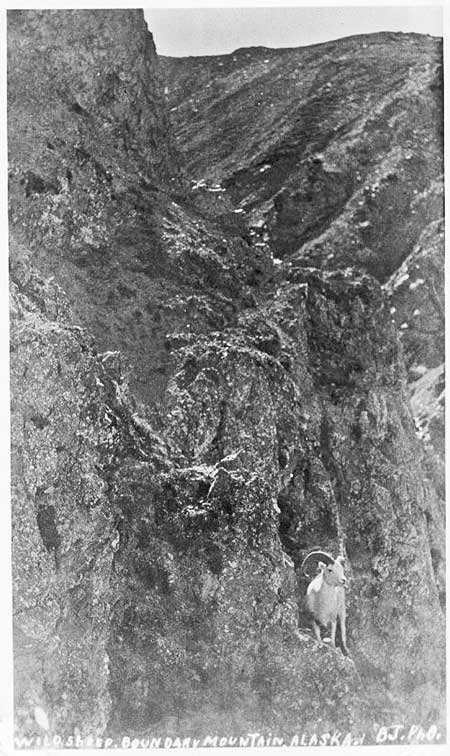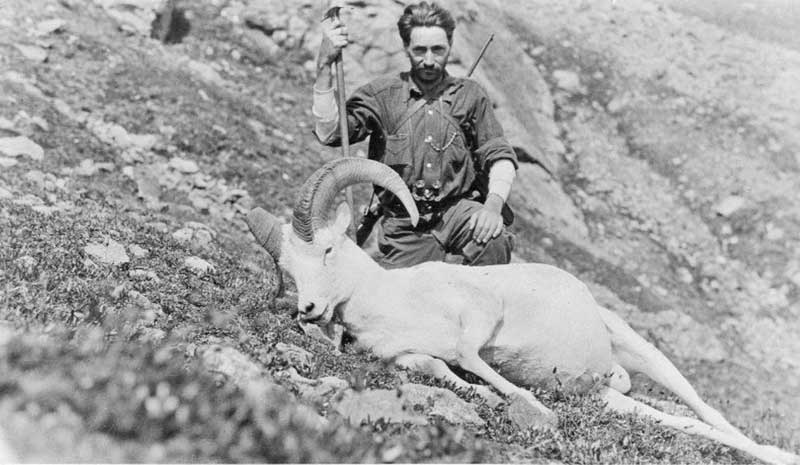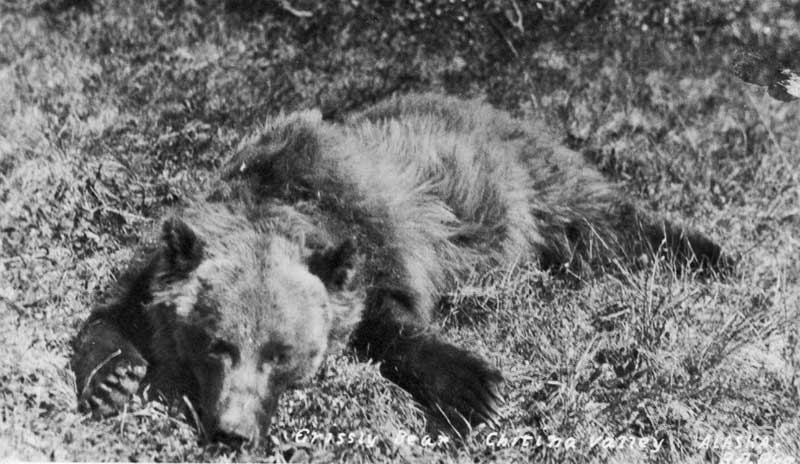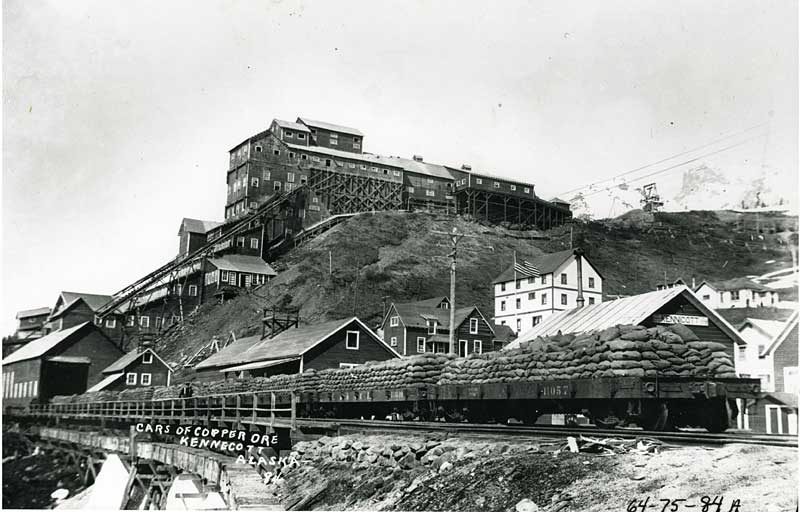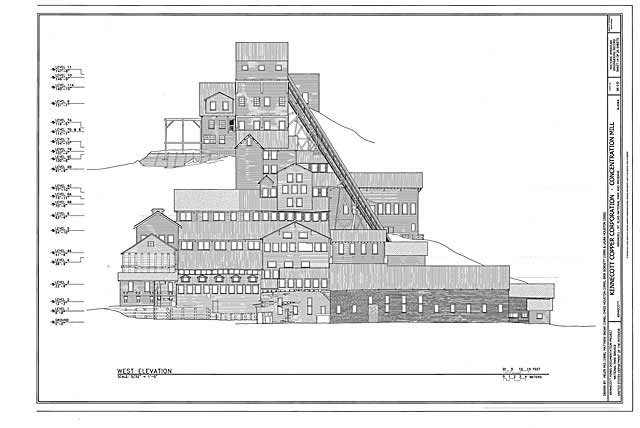Historic photo of "wild sheep, Boundary Mountain," in the Wrangell Range, Alaska, circa 1920s --Ben Jackson Photo
John Gadanski Captain Goodlataw Chittyna, Alaska Frank Buckner Kennecott Mines Company Kennecott, Alaska Dear Frank, We hope you are doing well there. Cap and I spent last fall in the guiding business,as you know. Cap told me you two had quite a time on that sheep-hunting trip when he brought you into Skolai country last year. I'm sorry I missed it. In the winters we have each been operating our own trap lines. Mine is up the Kotsina River, while Cap's is across the Copper River from Tonsina. The guiding business is not as good as it was a few years ago, especially since Dwyer's Inn burned at Strelna. The hunters who would stop at the lodge no longer come up now that the place is gone. Trapping is also down, probably because this entire area is largely trapped out. Also, pelt prices are not as good as before. Last summer we had a good season working for Kennecott out of Dad's shop. This summer we chose to stay close to home, working for the railroad. This winter we want to leave our trap lines to younger brothers so we can work up atKennecott again. The trapping no longer pays as well as the mines. Besides, we've never worked there in the winter. We want to be placed on the list after sheep-hunting season. We can work either in the mill yard or up in the mines. We only work away from Chitina as a team. We've been talking about this for some time. We look forward to another chance to work there. Please let us know if the superintendent agrees to rehire us. Regards, Johnny "Gakona" Gadanski Captain Michael Goodlataw July 25, 1926, Chittyna, Territory of Alaska |
Frank Buckner brought the letter into Bill Douglass’s office.
“Well, after all that has happened they want to come back? Quite a pair, those Indians. I take it the third one is not interested in returning?”
“That would be Charles. Evidently not, sir. I think he was shaken more than he showed by Henry’s fall. Those others are remarkable. They seem to adapt to any situation.”
Bill leaned back on his chair and set his glasses down. He swung around and looked out the window toward the tracks. The train which brought in the letter was being readied to haul another load of copper ore.
“As you know, Frank, we remain at a high production even though the mine is going into what appears to be an irreversible, steep decline. I was just looking at the figures. In the year you got here, which was 1923, we sent out 323 fully loaded trains of ore. That was the most ore we’ve ever run on the rails. We ran a full complement of thirty-five cars of ore every day we possibly could. We used up all the capacity that the railroad had to offer and maybe a little more.”
He turned around, placed his glasses back on, and read off his report.
“The next year we sent out 282 trains, then we bumped up to 290 trains in 1925. We were still running thirty-five cars averaging thirty tons each. Looks like it will be only slightly less this year. That means we’re still looking good for now. There’s still plenty of mining to be done here.
“Unfortunately our turn-over exceeds 200 percent. I’d say that we could probably use those two and any more like them just about anytime. Late fall is as good as any. I’d take them now if they asked. Sure we can use them. Tell them fall is okay with me.
“Thank you, sir. I believe Eldon Johnson could use them. That Erie section seems to have the highest turnover.”
“Wasn’t it one of them who guided you on that Skolai sheep-hunting trip?”
“Yes, sir. Cap took me into the high country. I had a good one in my sights, but Cap stopped me. He pointed out that the sheep would probably drop hundreds of feet into an area where it would be hard to recover the body. Besides, the carcass would be badly mangled. But it was well worth the trip. It got me away from work into some spectacular country. Cap is an interesting travel partner. He’s not at all what he appears to be. Very thoughtful and even
engaging once you get him talking.”
“Changing the subject, Frank, I want you to keep in mind that we will be looking for someone to open the Marvelous sometime in mid to late winter, according to the schedule we’ve worked out. You can have the job if Russell doesn’t want it. I’m not so sure Russell will be staying with us anyway. I get the impression he’s interested in other jobs elsewhere in the territory.”
“Yes, I get the same impression.”
Frank was not about to tell the superintendent that Russell Belvedere fully intended to leave for the Fairbanks Gold District soon. He would leave it to Russell to tell the boss.
“What about the Mother Lode upper camp? Do you intend to reopen it for the Marvelous job?”
“I’ve avoided using it since 1923. Chief Engineer Richelson advises me to shut it down permanently due to ongoing avalanche danger and other slide problems over there. Although it remains closed, I’m considering reopening the camp if it becomes expedient.
“We’re maintaining the camp just in case we need it. Everything remains in place so it would take very little to bring the camp back on line. We put quite a sum of money into that camp in 1920 installing a new boiler system and rebuilding the barrack and rec hall. It would be nice for the Mother Lode Coalition Company stock holders if we were able to recover more of their investment by using the camp one more season. It would save them the cost of renting barrack space from Kennecott. That would make some of them happy.”
“Is that really a good reason to reopen a camp your own chief engineer thinks is dangerous?”
“We don’t really know that, Frank.”
“Marvelous operations in the 600 level will resume this fall. We’ll station the crew at the Bonanza. Maybe I’ll give you charge of that operation. We’ll cut a new raise from the 800 to the 600 level so the miners can drop ore into skips at the Rhodes tunnel. Then we’ll tram the ore to the Bonanza side so we can hoist it to the surface.”
“Sounds like a good plan. I’ll be happy to engineer it if you let me. What do you think about the situation at Jumbo?”
“I think that mine is finished. We’re still extending the incline shaft, but we’re finding almost nothing. We’re following the guidelines that our high-priced company consultant Alan Bateman provided, but we’re not seeing any satisfactory results. All we seem to be doing is moving a lot of waste rock. I don’t really think there’s anything left to be found over there.”
“Let’s see what my latest report says.
“Hmm, well the Jumbo main vein is still doing well, though overall the output is way down. Production at the Porphyry fault vein and the 1506 and 908 veins has slackened. Deep diggings, but hardly worth it. It’s not looking too promising at all as we extend downward, is it?
“The depletion of the Jumbo emphasizes the point, doesn’t it? We need to prospect in the direction of Marvelous above the main Bonanza-Mother Lode vein. I know it’s a long shot, but there’s a large amount of unexplored ground that we’ve avoided because it’s so hard to get to from the Bonanza end. Our consultant agrees. Alan Bateman says we need to explore the Marvelous fully before closing out the area.”
“It doesn’t seem to be in a good area.”
“It’s not. It’s far away from the other workings and it doesn’t fit the theory that tells us where the ore should lie. Nevertheless, the old Mother Lode company mined some impressive copper ore out there, even though we have no idea why it would ever occur at that level.”
“It’s so far away from Bonanza that reopening the Mother Lode camp makes some sense?”
“Exactly. The time has come where we can no longer afford to put it off. With production declining so badly at the Jumbo and with the Bonanza almost dead since 1922, it’s time to take our remaining resources and go for those unexplored areas on the farthest reaches of our property.
“We have the lowest levels of Mother Lode, plus the Marvelous, plus whatever we find over there in the unexplored ground near the Erie. That’s all there is. Then we’re done. It’s that close.”
“Marvelous seems to be on the top of your mind.”
“It is. I want to get it over with and clear out of there. Now that I’m thinking about it, it’s time to call all of the engineers together to discuss Marvelous. We can start working that area from the Bonanza side in a matter of weeks if we get right on it.”
There was no doubt that Bill was determined to reopen the old ground above the old Mother Lode camp very soon. It made sense. Their exploration efforts elsewhere were not paying off.
Frank excused himself and started to walk out into payroll clerk’s office.
He turned around to shout out one last message to the boss.
“Should I go ahead and reply to Johnny’s letter?”
“Yes. Have him telegraph us first when he’s ready,” Douglass shouted through the door. “There’s plenty of work up in the mines.” .
“They work as a team,” Buckner reminded him.
“Yes, as a team,” Douglass replied.
Frank headed up the steep narrow stairs back to the map room. It was a sizable room on the upper level of a building that consisted of a series of additions. The map room was where the engineers drew up the mine maps. They had a blue-print machine there. The room was very bright due to the four large windows looking west. It was the true center of engineering for the mill and the mines.
Above the map room is a long attic that extended beyond the map room, over the second floor offices which were just south of the map room on the same level. The attic was a vast repository for all the engineering diagrams, structural prints and maps going back to 1907. Every detail of the underground workings existed on an engineering drawing which was rolled up and placed somewhere in the attic. The dim upper room also contained every blueprint for every structure on the site, along with a multitude of surface maps and engineering detail drawings of various machines and processes. There was always an engineer in the map room below the attic working on a new set of drawings which would ultimately find its way into this upper repository.
On this day, that man was Walt Richelson, the even-tempered and patient chief engineer who answered only to Douglass himself. While Walt lacked the magnetic personality of Bill Douglass, he shared Bill’s values. He understood what worked. What Bill did always seemed to work. Walt was a careful protege of the superintendent.
Richelson was examining his new surface drawings of the Jumbo and Bonanza mine sites as Frank entered the room from below.
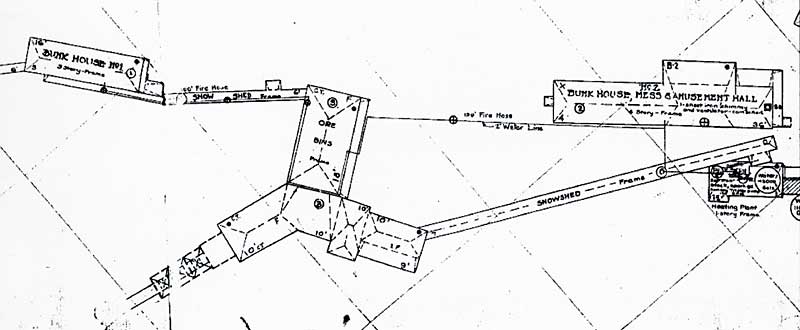 |
| Bonanza Mine upper camp site plan-1926 |
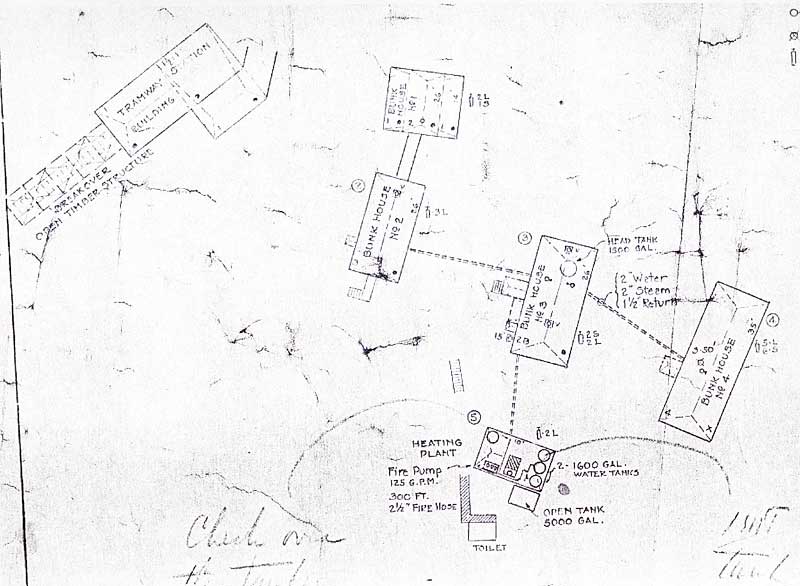 |
| Jumbo Mine upper camp site plan-1926 |
“Frank, these two drawings are ready to be run through the blue print machine. Since you just walked in, I’ll leave it to you.” He smiled at Frank and walked back to his upper-level office. Frank carefully examined the Jumbo drawing. He’d done the surveying for that one himself. Everything in the engineering office was a cooperative effort. The surface drawing looked very good. The map showed four barracks. Frank thought it odd that the drawing had come out so late. This map showed Jumbo as it had been since 1918 when the last of those buildings was erected. Now only two of the four barracks shown was still in use.
This is really a historic document. We don’t use half of what’s shown here. Won’t be long before none of it will be in use. If we ever need the use of a large camp facility again, we certainly have a good candidate up there. I’ll bet we could house 150 men there, if we had to. Right now, it’s more like a ghost camp.
The sun was shining brightly over the glacier. A gleam reflected back from an exposed piece of blue ice on the glacier, catching Frank’s eye. It was so bright that he had to turn his head away. Frank turned toward the other set of windows which looked up the hill, straight into the three-story white-painted staff house where he lived. The windows, framed in dark green trim, stared blankly back at him. At night it was home to eight engineers, two nurses, three teachers and the stenographer. They spent many hours up there playing cards together in one of the two comfortable sitting rooms, listening to the player piano or the Victrola, and otherwise just enjoying each others’ company. But at the moment no one was in there. Everyone was busy at work.
Someday that staff house will be as empty as it looks right now. No one will live there. I can imagine the wind blowing through broken glass and open doors. No other sounds. Just the wind. The whole camp will be empty and open to the elements.
This place is our life. It’s certainly my life. I’m a part of what this is. Kennecott isn’t just a place. It’s us. We’ll all be forgotten if Kennecott is lost. Once these buildings start to go, it will be like none of us ever existed.
Cars of ore at Kennecott, circa 1918 -W.C. Douglass Continue with Ch 44, "Kennecott Goes into Subtle Decline" |
